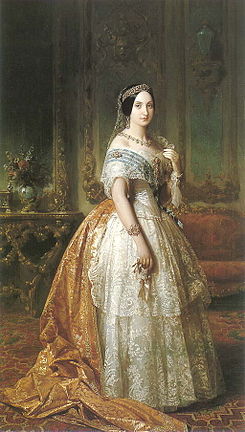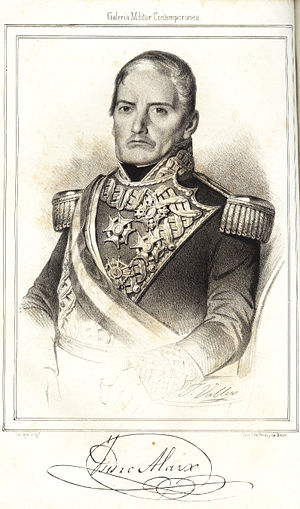Political Parties: Old and New
In the aftermath of the approval of the new constitution, numerous new parties rushed to organize and be recognized by the government in order to be able to compete in the elections. Although numerous parties rose across Spain, only two were large enough to compete in the national elections along with the Progresistas and the Moderados. The others due to their limited size were only able to participate in local municipal elections.
Progresistas – Spain’s ruling liberal party, led by Regent General Baldamero Espartero. The party enjoys widespread support from the lower and middle class particularly in most of the major cities and towns. Espartero’s government is immensely popular for bringing peace to Spain in the wake of the civil war, the expanded liberties granted in the new constitution, and the modest prosperity and industrialization that Spain has enjoyed due to Espartero’s financial reforms. However they suffer from internal divisions and without Espartero, they would face a serious struggle for leadership within the party. In addition, the new Partido Democrático, led by former Progresistas threatens to draw away voters from the Progresistas’ base.
Moderados- Spain’s moderate center-right party, the Moderados opposed abandoning the constitution of 1837 and advocate for serious changes to the current one. They seek to restore some of Monarchy’s powers. However, unlike the Traditionalist Party, they support the continuing reign of Queen Luisa not an absolute Monarchy under Don Carlos. While they recognize some religious liberties as legitimate, they oppose the confiscation of church land, they seek to have Catholicism declared the official religion of the state (not just the traditional one), and would like to implement formal restrictions on Jews, Protestants and other religious minorities from holding office or seeking new converts. They also favor greater centralization of authority and seek to eliminate the municipal councils, which were first established when Espartero took power in 1840. The Moderados have significant support from the upper class and enjoy the support of the majority of rural Spaniards outside of Vascongdas and Catalonia. The Moderados are still suffering from their association with the October Plot, and continue to suffer from a lack of unity. Their current leader, General José Ramón Rodil y Campillo, had originally been a Progresista; however, a personal rivalry between him and Espartero had developed. He believed the Progresistas had gone way too far in the new constitution and switched his loyalty to the Moderados in early 1843. [1] He was elected as a compromise candidate all factions could live with; however, he was not widely trusted amongst the party’s leaders. The general is a hero of the Wars of Independence in South America and of the recent civil war. In particular his fanatical defense of Callao, the last Spanish holdout in Peru is considered legendary. The Moderados hope his popularity will give them the boast at the polls that they desperately need.
General José Ramón Rodil y Campillo, leader of the Moderados
Partido Democrático (the Democrats) The leaders of Democrats are all Progresistas who feel the new constitution has not gone far enough. They are advocates for universal manhood suffrage. They also seek to repeal the Monarchy’s few remaining powers, such as casting the deciding vote, nominating Supreme Court Justices, etc. They also campaign for increased acess to education for poorer Spaniards (to order to increase literacy rates and thus expand the electorate) and greater protections for Spain’s small but growing number of industrial workers. Their support comes mainly from the working class in major cities, in particular the increasingly industrialized cities of Barcelona (center of Spain’s textile industry) and Bilbao (the center of Spain nascent iron industry). However, the party is split internally between Republicans and Constitutional Monarchists. For now, the Monarchists are the majority and their leader, Cristino Martos leads the party. However, the split will remain a source of constant tension within the party.
Cristino Martos, leader of the Partido Democrático
Partido Tradicionalista – The Traditionalist Party is the official party of the Carlists. They advocate for what they call the “restoration of Carlos V”, aka the installment of Don Carlos as king. They regard any constitution as illegitimate and seek to replace the current constitutional system with an absolute monarchy. However, one of their main aims is to amend the constitution to eliminate the article removing Carlos from the succession. [2] They are also staunchly opposed to the seizure and sale of church property by the state, as well as the allowance of any freedom of religion. In fact, some of its members strongly advocate for the reintroducing of the Inquisition. The party enjoys support in Catalonia and Vascongadas (areas which sided with the Carlists in the Civil War) and amongst the clergy across Spain. However, the Carlists are mistrusted by the military (dominated by generals who fought against Carlists in the civil war) and any serious electoral victory by them could easily spark a coup. Additionally, many Carlist leaders have refused to participate in parliamentary process, thinking their participation would give it legitimacy. Furthermore, most of the senior Carlist leadership had been forced to flee abroad by this point, so the Traditionalists are led by a young but brilliant priest, Father Jaime Balmes y Urpiá.
Father Jaime Balmes y Urpia, leader of the Traditionalist (Carlist) Party
[1] In OTL there was a rivalry between Rodil and Espartero, however it simply lead to the end of Rodil’s political career. In TTL, the Moderados lack a strong or popular leader (their OTL leader at this time was Narvaez, who is now in exile). The Moderados are desperate and hope Rodil’s war hero status will help them in the polls and maybe even swing some more conservative Progresistas to their side.
[2] Unlike OTL, where Isabel II had an heir in Luisa, Luisa lacks a clearly accepted one. The succession would traditionally go to Carlos as he is her eldest uncle. However, as result of the constitution, Luisa’s currentA heir is her other uncle, Prince Francisco de Paula. The situation is complicated further by the fact that there are widespread rumors that Francisco is the bastard of Manuel Godoy (Carlos IV’s hated prime minister) and Queen Maria Luisa de Parma (Carlos IV’s wife). As a result, Carlos thinks he can afford to play the waiting came because if Luisa dies without issue, he will have a much stronger claim on the throne.










